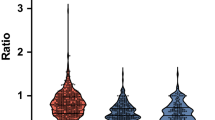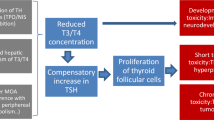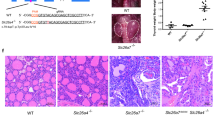Abstract
IT has been known since 1941 that sulphonamides influence the thyroid gland. MacKenzie, MacKenzie and MacCollum1 note that rats on a purified diet containing 1–2 per cent of sulphanilylguanidine show hypertrophy of the thyroid gland. The action is not influenced by yeast, p-aminobenzoic acid, or excess of iodine. Somewhat later2, sulphadiazine, sulphathiazole, sulphapyridine and sulphanilamide were found to produce a similar effect. Basal metabolism is lowered by any sulphonamide, and sulphanilamide is the least active one. Taurog, Chaikoff and Franklin3 showed that sulphonamides and similar products inhibit the formation of diiodotyrosine and thyroxin by living tissue slices of thyroid in vitro, in presence of radioactive inorganic iodine.
This is a preview of subscription content, access via your institution
Access options
Subscribe to this journal
Receive 51 print issues and online access
$199.00 per year
only $3.90 per issue
Buy this article
- Purchase on SpringerLink
- Instant access to full article PDF
Prices may be subject to local taxes which are calculated during checkout
Similar content being viewed by others
References
MacKenzie, MacKenzie and MacCollum, Science, 94, 518 (1941).
MacKenzie and MacKenzie, Endocrin., 32, 185 (1943).
Taurog, Chaikoff and Franklin, J. Biol. Chem., 161, 537 (1945).
Libermann, D., C.R. Acad. Sci., in the press.
Astwood, J. Pharmacol, and Exp. Therap., 78, 79 (1943).
Nogales, Tarrida and Castello, Medicina Clinica, 6, 420 (1946).
Györgyi, Stiller and Williamson, Science, 98, 518 (1943).
Miller and Roblin, J. Amer. Chem. Soc., 67, 2197 (1945).
Author information
Authors and Affiliations
Rights and permissions
About this article
Cite this article
LIBERMANN, D. Sulphonamides and the Thyroid Gland. Nature 158, 557 (1946). https://doi.org/10.1038/158557a0
Issue date:
DOI: https://doi.org/10.1038/158557a0
This article is cited by
-
Browsing of Patella
Nature (1946)



